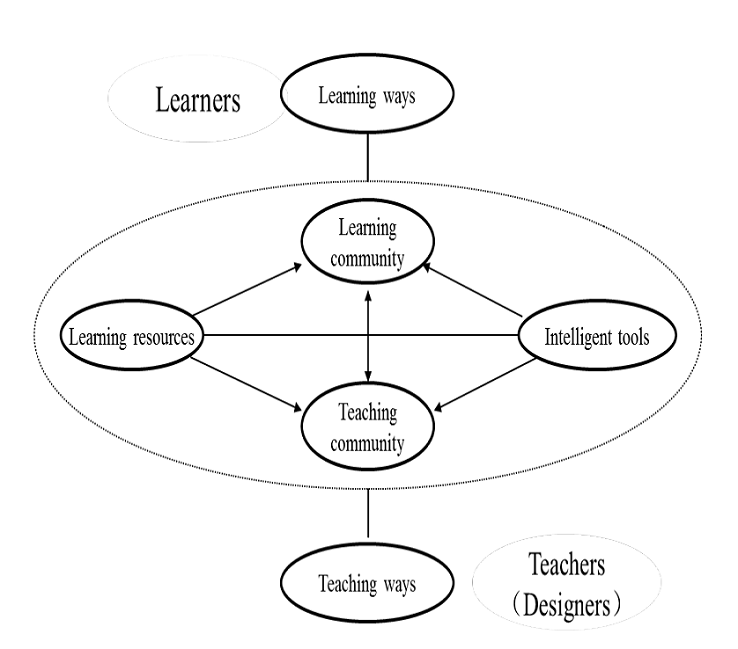Five Components of a Smart Learning Environment
Five Components of a Smart Learning Environment
This section presents five (5) aspects that form the components of SLE, being a new learning space that realizes the integration of the physical environment and the virtual environment. Bearing in mind, the overall goal for designing SLE is to make learning space sense learning scenarios, identify the characteristics of learners, provide appropriate learning resources, automatically record the learning process and evaluate learning outcomes in order to promote an effective learning experience. A SLE components include:
1. The Teacher
The teacher provides the human touch in a personalized learning environment. A teacher perform a number of roles:
i . Facilitator / Learning Manager: If instructional materials really become individualized, there will need to be someone present to help students navigate the technical aspects of performing the work that the system pushes to them. Additionally, the instructor will have a role in keeping students on task, and in providing support when learners fail to reach the standards pre-programmed into the adaptive learning system. There may also be an increased role in making sure that each student is completing their own work, rather than the work of peers.
ii. Remediator: When students fail to achieve the learning objectives outlined by the automated system, the instructor will need to step in to troubleshoot the learning disconnect and either provide alternative instruction or adjust the learning system through some sort of control interface.
iii. Enricher: Playing off the flipped classroom model, the teacher's role could shift to providing enrichment activities beyond the scope of the automated system. If adaptive content is provided that helps students master basic concepts and learn background information, teachers can focus on helping students use the information that they have gained in authentic ways to help turn it into knowledge.
iv. Collaborator / Mentor: One intriguing possibility in a technology-facilitated education future is for teachers to serve as collaborators and mentors with students engaging in real-world, possibly entrepreneurial, activities. Such activities would help students develop actual marketable skills and could potentially provide a new and much needed revenue stream for schools and universities.
v. Content Creator: One role that teachers already have –unless their curriculum is standardized- is that of content creator. This is actually one of the most important functions that educators at all levels perform, and one for which they are well trained. Add to these qualifications the fact that they actually know their students, their strengths, weaknesses, and capabilities, and educators could become a valuable resource to be employed to help bolster the content in these adaptive systems. This serves the additional purpose of de-centralizing the curriculum so that a diverse set of perspectives and ideas can be assured.
2. The Learner
All learners explore their own abilities, interests, and needs to communicate them to teachers. The fruit of this communication is creative learning tasks with which students are welcome to experience. The students, therefore need to examine their skills while meeting the new challenging learning tasks and elevate them. Learners communicate their process of learning and challenges encountered to the teachers, being given advice on how to improve their learning. They conclusively present their products to the class to assess the learning of all the class.
As shown in Figure 1, learners and teachers are the focused users of SLE. They interact with other elements such as learning resources, intelligent tools, learning community, and teaching community.

Figure 1. Overview of SLE components and interactions
Learning resources and intelligent tools provide support to both the learning community and the teaching community. The development of the learning community and teaching community is inseparable from the resources and tools.
3. Learning Resources
For many people, the words educational materials invoke images of large, print, classroom textbooks with small type, outdated information, and content that covers the breadth but not depth of a subject. But learning resources are more than that. They are any tool that helps teachers teach and students learn.
Learning resources include the followings:
Textbooks (print and digital) Workbooks Worksheets Manipulatives (blocks, beads, etc.) Flashcards Educator workshops Non-fiction books Posters Educational games | Apps Websites Software Online courses Activity books Graphic novels Reference books DVDs CDs Magazines & periodicals | Study guides Teacher guides Labs Models Movies Televisions shows Webcasts Podcasts Maps & atlases |
We acknowledge that students can't learn from one type of instructional material alone and believe that it's the educators, parents, and administrators who can best determine what content will be effective for learners. Supplemental resources help teachers differentiate instruction and engage students who, for whatever reason, need enrichment beyond the core classroom material. No matter which materials are used, though, parents and educators should hold all instructional content providers accountable for the quality of their learning resources.
Figure 2 concretely depicts the components of a smart learning environment where the learning and teaching ways are generally referred to as pedagogy .


Figure 2. Representation of the five components of a smart learning environment
Currently, measuring the degree of 'smartness' in smart learning environments might be challenging since standardization is still required in this emerging field. Therefore, experts in this field approach the matter by providing and adhering to attributes, criteria, and elements that define SLE. These attributes of SLEs are presented and compared with common digital learning environments in Table 1.
4. Smart Technology / tools
5. Pedagogy
Table 1: Comparison of Common Digital Learning Environments and Smart Learning Environments (Adapted from Singh & Hassan, 2017)
Components | Common Digital Learning Environment | |
Learning Resources | 1) Digital resources based on rich media. 2) Online access becomes the mainstream; and 3) Users select resources. | 1) Digital resources are independent of the devices. 2) Seamless connection or automatic synchronization become fashionable; and 3) Deliver on-demand resources. |
Learning tools | 1) Tools with all-in-one functions, systematized tools. 2) Learners judge the technology environment; and | 1) Specialized tools and miniaturized tools. 2) Automatically sensing technology environment; and |
Learning community | 1) Virtual community focusing on online communication. 2) Self-selected community; and 3) Restricted to information skills. | 1) Combined with the mobile interconnected real community to communicate anytime and anywhere. 2) Automatically matched communities; and 3) Dependent on media literacy. |
Teaching Community | 1) Difficult to form a community, which is highly dependent on experience.and 2) Make the regional community possible. | 1) Automatically form a community, which is highly concerned about the users' experience; and 2) Make the cross- regional community fashionable. |
Learning Methods | 1) Focus on individual knowledge construction. 2) Focus on low-level cognitive objectives. 3) Unify evaluation requirements; and 4) Interest becomes the key to the diversity of learning methods. | 1) Highlight the knowledge construction of community collaboration. 2) Focus on high-level cognitive objectives. 3) Multiple evaluation requirements; and 4) Thinking becomes the key to the diversity of learning methods. |
Teaching Methods | 1) Emphasize resource design and explanation. 2) Summative evaluation of the learning outcomes based on the learners’ behaviours; and 3) Observation of learning behaviours. | 1) Emphasize activity design and guidance. 2) Adaptive evaluation of learning outcomes based on the cognitive characteristics of learners; and 3) Intervention in learning activities. |
The designs of SLEs take into account the formal and informal learning settings. Learner’s context, knowledge domain, personalization, cultural resources, adaptation, and socio-cultural features are important factors to consider in the design of SLEs. Description of different contexts for the design of SLEs: Context
Figure : A taxonomy of context entities (Hasanov and Laine, 2017) Hwang (2014) identified context-awareness; adaptiveness; and ability to adapt user interface, subject content, and report learning status as the key criteria of a SLE. Figure 3 describes the modules of Hwang’s SLE system. Figure : Contextual Framework of a SLE (Hwang, 2014) Figure below describes the smart learning framework of Liu et al. (2017). The model positions the learner in the centre, and consists of four levels (learning experience, support technologies, learning scenarios, and basic principles of teaching and learning).
References
Spector, J. M. (2015). Foundations of educational technology: Integrative approaches and interdisciplinary perspectives. Routledge.
Singh, AD, & Hassan, M. (2017). In pursuit of smart learning environments for the 21st century (Current and critical issues in curriculum series, No. 12, IBE / 2017 / WP / CD / 12). Geneva: UNESCO. Retrieved June , 17 , 2018.
